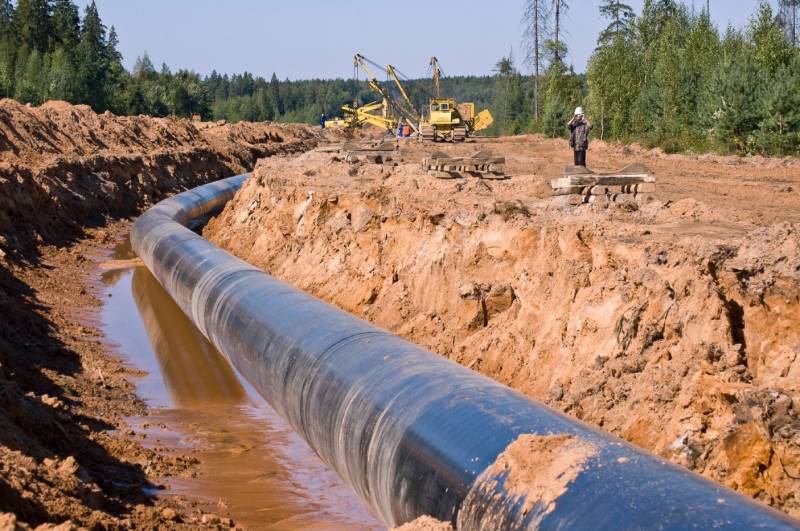In exchange for the supply of hydrogen, Russia can receive carbon dioxide from the EU for disposal
On September 7, 2021, a significant event took place. The Gazprom corporation has reported that the last joint on the Nord Stream-2 subsea gas pipeline has finally been completed. Now the matter remains with the commissioning work, and, more importantly, with the legal issues - the certification of the pipeline, as well as its exclusion from the norms of the EU's Third Energy Package, so that the domestic monopolist can fill both lines with gas. However, it is possible that on the horizon of the next 10 years this problem will be solved by itself, since the pipeline will be filled not with natural gas, but with “multi-colored” hydrogen.
In this matter, Gazprom will completely depend on the ambitions of its main partner in Europe, Germany. The EU has set a goal to achieve full "decarbonization" economics Of the Old World by 2050, and Berlin intends to go ahead of everyone. Germany is consistently abandoning coal and nuclear power generation in favor of renewable "green" energy sources. During the transition period, environmentally harmful energy sources should be replaced by natural gas. Germany diversified its gas supplies to the maximum by building LNG terminals on the coast and defending its right to additional pipelines from Russia against the United States. All this should turn Germany into the largest gas hub of the European Union, significantly increasing its energy security and influence on its neighbors in the EU.
But what will happen next? 30 years is not so little. What will the European energy market look like? Are Berlin and Brussels really counting on just windmills and solar panels? Whatever one may say, it will not be possible to do without balancing capacities, the recent sad example of Texas will confirm this. Some kind of permanent generation is needed, and if Europeans are fundamentally abandoning fossil fuels, then what will replace it?
One of the most promising areas today is considered to be hydrogen energy, which rightfully belongs to the "alternative". Hydrogen is one of the most abundant elements on our planet and in space, its combustion temperature is high, and the product of this chemical reaction is simple water, which can be reused later. There is a "color" classification of hydrogen depending on of technologies its receipt and the raw materials used in this process. The most desirable "green" hydrogen in Europe is produced by electrolysis of water using renewable energy sources (RES). Goluboy is produced from natural gas and uses technologies to capture and store carbon dioxide. "Gray" is also produced from gas, but harmful emissions are released into the atmosphere. Finally, "red" hydrogen is produced by electrolysis of water at nuclear power plants.
It is obvious that the future of the world economy belongs to hydrogen fuel. The EU intends to maintain its leadership, and Russia objectively has every chance to defend its position as the main supplier of energy resources. Ecologically obsessed Europeans can be supplied with "green", "blue" and even "red" hydrogen, and for this the newest Nord Stream 2 pipeline will be involved. This was previously stated by the executive director of Nord Stream 2 AG Matthias Warnig.
It is quite realistic that no later than ten years from now, we will be able to add hydrogen to one or both strings.
Indeed, unlike the gas pipelines of the previous generation, Nord Stream 2 was built in such a way that, after a certain technical revision, it could be used to pump a more “aggressive” type of fuel in relation to the metal from which the pipeline is made. And how might a "hydrogen" scheme of cooperation between Russia and the European Union look like?
There is hydrogen
According to publicly available information, Gazprom's management has already proposed to pump to Germany via Nord Stream 2, not natural gas, but hydrogen. Probably, we are talking about some of its mixture with methane in order to reduce the risks of corrosion of the pipeline system. A large methane pyrolysis plant can be built at the site of the gas pipeline in Germany. In the production of hydrogen in Germany, it is possible to use renewable energy sources, which will make it "green". Taken together, this solution will make it possible to obtain fuel with a carbon footprint three times lower than allowed by EU environmental standards.
Reverse - carbon dioxide
A separate question concerns what to do with carbon dioxide, which accumulates in the production of hydrogen in more budgetary ways than “green” ones. Gazprom is ready to help the European Union here too. One of the top managers of the state corporation, Alexander Ishkov, explained:
The project, which, I think, has never been discussed by anyone <...> is the analysis and assessment of the possibilities of reverse, or reverse transportation, CO2 to Russia when obtaining hydrogen by cheap traditional methods, such as methane conversion. And CO2 through the existing infrastructure of gas pipelines can be delivered back to Russia for disposal or for utilization in other ways.
At first glance, it doesn't sound very good. However, if you look at the issue, the picture begins to change. CO2, for example, can be used in oil production. Injection of carbon dioxide into the well reduces the viscosity and increases oil recovery by 15%, which is very significant. Since 2017, this technology has been used on the Norwegian continental shelf by Statoil, Shell and Total as part of a partnership agreement for the CCS (carbon capture and storage) carbon capture and storage project. In addition, former oil reservoirs can be converted for CO2 storage by charging a fee.

Information